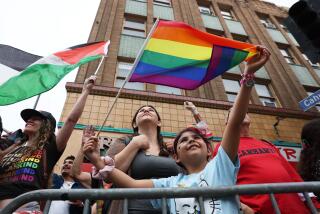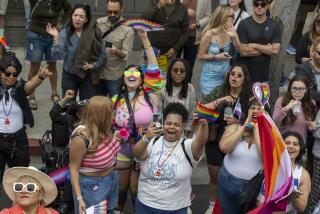Months before Alton Sterling was shot, Baton Rouge parade floats seemed to mock Black Lives Matter
The Spanish Town Mardi Gras Parade has long been known for its borderline humor. But this year, some wondered if the Baton Rouge tradition had gone too far.
One of the floats displayed a sign that said âPink Lives Matterâ with a drawing of a flamingo being beaten with a police baton and a sign around its neck saying, âI canât breathe.â Some observers were angered because they thought the float was mocking the death of Eric Garner and the Black Lives Matter movement his death helped inspire.
Garner died in 2014 in New York City after being put in a chokehold by police and repeatedly pleading, âI canât breathe.â
Now the Louisiana capital has rocketed back into the news following the death of a black man named Alton Sterling, who was pinned down and shot by police Tuesday outside a convenience store. The incident has prompted a federal investigation and, again, has renewed concerns about race, police and the use of deadly force.
It has also left some questioning whether some entries in the cityâs colorful and risque parade stoke racist sentiments.
Another float in the parade, which is held annually by a nonprofit dedicated to preserving Baton Rouge traditions, appeared to refer to Freddie Gray with the words âFreddie Gray Goose.â Gray suffered fatal spinal cord injuries after being transported in a police van in Baltimore last year. His death touched off citywide street protests.
Southern University law student Shelley Moore was among those who thought the floats in the February parade crossed the line.
âWhat is funny about a man being choked to death by the police? Where is the humor in a man being placed in the back of a police vehicle and thrown around so violently that his spine was almost severed? I am not amused,â Moore wrote in a blog post.
âTo accept what I witnessed as the Spanish Town Parade today is to accept outright racism, and I will not stand for it,â she added.
Bill Brumfield, president of the Spanish Town Parade since 2001, defended the float, saying it was not meant to be racist.
âOur attempt was to say all lives matter â black, white, yellow, pink, everybody. Everybodyâs life matters. We donât draw color distinction,â he said.
Brumfield, who has been the subject of some of the paradeâs jokes in the past, explained that organizers donât attempt to control the floatsâ content in any way.
âThey are allowed to express themselves however they see fit,â said Brumfield.
âLast time I checked, this is still America and I believe we still have the right to free speech. If youâre offended by someoneâs opinion, then take it up with him,â he said.
The Spanish Town Mardi Gras website declares, âour worldview is that âpoor taste is better than no taste at all!â â
Tara Wicker, a Baton Rouge councilwoman, heard multiple complaints about the floats and said that she had communicated with attorneys about how to place general regulations on the paradeâs content without infringing on 1st Amendment rights.
âWhen you put together an event, you have to look at how it is going to be perceived by the community. How are people going to respond? How are people going to feel?â she said.
Racial tension is not new in Baton Rouge. The town is divided by what Wicker calls the cityâs Mason-Dixon line, which she said separates the predominantly black north from the majority white southern portion of the city. Wickerâs council district spans both sides of the divide.
âFor a long time the segregation was by design. No we are living with the results of years of discrimination,â Wicker said.
In 2015, many Baton Rouge residents signed the St. George Petition that sought to separate the cityâs southern region from the north. Signatories said they wanted to see their tax dollars better spent to improve schools, but opponents felt the petition was racially motivated.
Although the petition failed by a small margin, organizers said they plan to reintroduce it next year, The Advocate reported.
Racial discrimination also affects police work in the city, according to Wicker, who said she is looking to remedy the issue with community policing and programs that incentivize police to live in the neighborhoods where they work.
âWe do have pockets of police officers that for whatever reason are not sensitive to certain communities, and it comes out in the ways that certain members of that community are treated,â she said.
ALSO
Cellphone video captures Baton Rouge police shooting black man
After 150 years, Ku Klux Klan sees opportunities in U.S. political trends
Off-duty LAPD reserve officer fatally shoots armed man inside Carlâs Jr. in Covina
More to Read
Sign up for Essential California
The most important California stories and recommendations in your inbox every morning.
You may occasionally receive promotional content from the Los Angeles Times.










